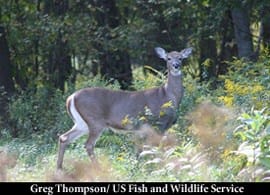Oftentimes your hunt really begins once you’ve shot or arrowed a deer. Only after you’ve recovered the animal can you call your hunt a success. Let’s look at 10 steps to help you locate your downed whitetail. You can learn more about hunting deer in my book, “Deer Hunter’s Pocket Reference” at http://www.protoolindustries.net/fears/index.html.

1. Look
As soon as you squeeze the trigger on your bow or rifle, watch the reaction of the deer, especially the deer’s tail. A raised tail means you may have missed the deer. If the deer’s tail points out, you more than likely have hit the deer. A deer with a tucked tail generally means you have a good hit. After watching the deer for as far as you can see him travel, pick-out a landmark that you can find at ground level where you’ve last spotted the deer.
2. Listen
If you don’t see the deer go down, listen to see if you can hear the deer stumble and fall. Often you can hear a deer fall when you can’t see it. Try to determine exactly where you think the sound has originated. Listen for any other sounds that may indicate the movement of the deer.
3. Wait
If the deer has fallen, it won’t go anywhere. If you’ve only wounded the deer, by waiting, you’ll give the deer a chance to succumb. If you don’t wait, you may startle the wounded deer causing him to jump up and run off. Oftentimes the longer you delay your search for the deer, the more your odds will increase for recovering that animal.
4. Get a bearing
Before you leave your tree stand or ground blind, use your compass or global positioning system (GPS) to mark the direction of flight the deer takes away from your tree stand to the last point where you’ve spotted the deer. Take another bearing to mark the place where you think you’ve heard the deer fall because the terrain may look differently once you’re at ground level. Taking these bearings will help you stay on-course as you travel from your stand to where you expect to recover your deer.
5. Identify the point of impact
When you leave your stand, go directly to the spot where you think the shot has hit the deer. Search for hair, blood, bone and stomach content. The hair you discover often will tell you where the shot has hit the deer. The deer’s shortest and darkest hair covers the top of his back; his stomach will have the lightest-colored and longest hair; and he will have short white hairs under his chin, inside his ears and on his tail. Also, if you locate blood with air bubbles in it, you’ve more than likely made a lung shot. If you find stomach content, you’ve probably hit the deer low and may need to wait several hours before you begin tracking the animal. Try to obtain all the information you can from the place where you’ve hit the deer.
![]()
6. Follow blood and tracks
If there’s no blood trail, you may have to rely on tracks and what you’ve already seen and heard to find your buck. Study the tracks of the animal noting the size and shape. Identify any characteristics that will help you distinguish this deer’s track from another’s.
7. Leave a flagging-tape trail
Leaving a flagging-tape trail will enable you to see the deer’s direction of travel. You also can find your way back to your tree stand and the last place where you’ve located the deer’s blood with flagging tape.
8. Go slow
Many hunters fail to find the deer they’ve shot because they hurry too much and lose the trails. Go as slowly as required to stay on the trail, even if you have to get on your hands and knees to search for pinhead-sized drops of blood or study tracks.
9. Look up
Oftentimes you may find no blood on the ground. But if you’ll look up, you may pinpoint blood waist high on trees, bushes and leaves due to the surrounding foliage collecting the running deer’s blood before it can fall to the ground. This is especially the case if you’ve made a lung shot.
10. Know what to do when the blood runs out or the trail stops
When the blood trail ends, and I can no longer find a trail, I hang flagging tape as high in the tree as possible to allow me to see it from a long distance. Then, I begin to walk in a circle expanding the radius of the circle with each revolution. If you have a GPS receiver that will mark a trail as you walk in a circle, you can see on the receiver’s screen where you’ve walked. Many times when the deer’s trail runs out, you’ll discover the deer within 100 yards of the trail’s end. Knowing that a wounded deer often tries to bury-up in thick cover, thoroughly check out downed trees, brush piles and any other thick cover areas within that 100-yard circle. Also, continue scanning for tracks and blood while you walk the circle.
I may follow a deer for 4 hours or longer using these steps before recovering the animal. These tactics will work for you too.







